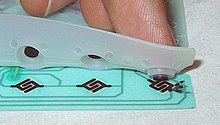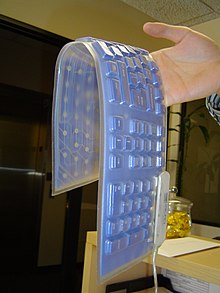Keyboard technology

There are many types of keyboard, usually differentiated by the switch technology employed in their operation. Since there are so many switches needed (usually about 80-110) and because they have to be highly reliable, this usually defines the keyboard. The choice of switch technology affects key response (the positive feedback that a key has been pressed) and travel (the distance needed to push the key to enter a character reliably). Newer models use hybrids of various technologies to achieve greater cost savings.
Types
Dome-switch keyboard

Dome-switch keyboards are kind of a hybrid of membrane and mechanical keyboards. They bring two circuit board traces together under a rubber "dome" or bubble. The inside of the top of the bubble is coated in graphite. When a key is pressed, it collapses the dome, which connects the two circuit traces and completes the connection to enter the character. The pattern on the PC board is often gold-plated.
This is a common switch technology used in mass market keyboards today. It is considered very quiet, but purists tend to find it "mushy" because the collapsing dome does not provide as much positive response as a hard closing switch. These are also a good choice for office or consumer environments because they are generally fairly quiet. This switch technology also happens to be most commonly used in handheld controllers, such as those used with home video game consoles.
Dome-switch keyboards are also called direct-switch keyboards.
Scissor-switch keyboard
On a scissor-switch keyboard, the keys are attached to the keyboard via two plastic pieces that interlock in a "scissor"-like fashion, and snap to the keyboard and the key. Scissor-switch technology does not use a rubber-plunger assembly[citation needed] like most other keyboards. Scissor-switch keyboards are normally responsive and crisp. These keyboards are generally quiet. The keys require little force to press.
This keyboard technology is mainly used in laptops.
Capacitive keyboard
In this type of keyboard, pressing the key changes the capacitance of a pattern printed on a PC board. Usually this permits a pulse or pulse train to be sensed. Unlike "dome switch" keyboards, the pattern will be covered by a thin, insulating film. Capacitive keyboards are inexpensive, and resist wear, water, foreign objects and dirt. They are common in PC keyboards.
Mechanical-switch keyboard
Mechanical-switch keyboards use real switches, one under each key. Depending on the construction of the switch, these keyboards have varying responses and travel times. Notable keyboards utilizing this technology are the Apple Extended II, and its modern imitator, the Matias Tactile Pro. These two keyboards use ALPS switches. Cherry Corporation of Germany also makes mechanical switches used in special purpose and high end keyboards. In India, the TVS Gold mechanical keyboard is very popular despite costing about five times a membrane keyboard.
Buckling-spring keyboard
Many typists prefer buckling-spring keyboards. [1][2] It is a common misconception that the IBM Model M and its derivates are mechanical-switch keyboards. In fact, the Model M uses membrane-sheet switches, much like those found in a dome-switch keyboard. The buckling spring mechanism (U.S. patent 4,118,611) atop the switch is responsible for the tactile and aural response of the keyboard. This mechanism controls a small hammer that strikes the membrane switch.[3].
In 1993, two years after spawning Lexmark, IBM transferred its keyboard operations to the daughter company. New Model M keyboards continued to be manufactured for IBM by Lexmark until 1996, when Unicomp purchased the keyboard technology. Today, Unicomp manufactures new buckling-spring keyboards and repairs old IBM and Lexmark keyboards. Unfortunately, the later Lexmark-manufactured Model M keyboards are of inferior quality to the original IBM-manufactured Model M. The plastic used is of lower grade (density) and other features such as a detachable heavy duty keyboard cord were replaced by cheap substitutes.
Hall-effect keyboard
Hall effect keyboards use magnets and Hall effect sensors instead of an actual switch. When a key is depressed, it moves a magnet, which is detected by the solid-state sensor. These keyboards are extremely reliable, and are able to accept millions of keystrokes before failing. They are used for ultra-high reliability applications, in locations like nuclear powerplants or aircraft cockpits. They are also sometimes used in industrial environments. These keyboards can be easily made totally waterproof. They also resist large amounts of dust and contaminants. Because a magnet and sensor is required for each key, as well as custom control electronics, they are very expensive.
Laser keyboard
A laser projection device approximately the size of a computer mouse projects the outline of keyboard keys onto a flat surface, such as a table or desk. When the laser is interrupted in the position of a key, a keystroke is registered. This type of keyboard is portable enough to be easily used with PDAs and cellphones, and many models have retractable cords and wireless capabilities. However, sudden or accidental disruption of the laser will register unwanted keystrokes. Also, if the laser malfunctions, the whole unit becomes useless, unlike conventional keyboards which can be used even if a variety of parts (such as the keycaps) are removed. This type of keyboard can be cumbersome to use since it is susceptible to errors, even in the course of normal typing, and its complete lack of tactile feedback makes it even less user-friendly than the cheapest membrane keyboards.
Membrane keyboard
Membrane keyboards are usually flat. They are most often found on appliances like microwave ovens or photocopiers. A common design consists of three layers. The top layer (and the one the user touches) has the labels printed on its front and conductive stripes printed on the back. Under this it has a spacer layer, which holds the front and back layer apart so that they do not normally make electrical contact. The back layer has conductive stripes printed perpendicularly to those of the front layer.
When placed together, the stripes form a grid. When the user pushes down at a particular position, his finger pushes the front layer down through the spacer layer to close a circuit at one of the intersections of the grid. This indicates to the computer or keyboard control processor that a particular button has been pressed.
Membrane keyboards do not generally have much of a "feel", so many machines which use them issue a beep or flash a light when the key is pressed. They are often used in harsh environments where water or leak proofing is desirable. Although used in the early days of the personal computer (on the ZX80, ZX81 and Atari 400), they have been supplanted by the more tactile dome and mechanical switch keyboards. However, membrane keyboards with interchangeable key layouts, such as the IntelliKeys and Discover:board are still commonly used by people with physical, visual, or cognitive disabilities as well as people who require assistive technology to access a computer.
Roll-up keyboard

Some keyboards are designed out of flexible materials that can roll up in a moderately tight bundle. Normally the external materials are either silicone or polyurethane. It is important to note that although many manufacturers claim that the keyboards are foldable, they cannot be folded without damaging the membrane that holds the circuitry.
Typically they are completely sealed in rubber, making them watertight like membrane keyboards. Like membrane keyboards, they are reported to be very hard to get used to, as there is little tactile feedback.
Currently (as of 2005), a number of keyboards that can roll up are being sold commercially. Such keyboards include:
- the CoolMac keyboard [1],
- the Eumax keyboard,
- the VIK ("virtually indestructible keyboard") [2], [3],
- the pocket VIK [4],
- the Flexboard keyboard [5],
- the CoolMIR keyboard [6], and
- the Whitelite FX100 Keyboard [7].
See Roll-away computer.
Other parts of the PC keyboard
The modern PC keyboard is more than just the switch technology, however. It also includes a control processor and indicator lights to provide feedback to the user about what state the keyboard is in. Depending on the sophistication of the controller's programming, the keyboard may also offer other special features.
The processor is usually a single chip 8048 microcontroller variant. The keyboard switch matrix is wired to its inputs and it processes the incoming keystrokes and sends the results down a serial cable (the keyboard cord) to a receiver in the main computer box. It also controls the illumination of the "caps lock", "num lock" and "scroll lock" lights.
A common test for whether the computer has crashed is pressing the "caps lock" key. The keyboard sends the key code to the BIOS code running in the main computer; if the main computer is operating, it commands the light to turn on. All the other indicator lights work in a similar way. The BIOS also tracks the shift, alt and control state of the keyboard.
When pressing a keyboard key, the key "bounces" like a ball against its contacts several times before it settles into firm contact. When released, it bounces some more until it reverts to the uncontacted state. If the computer was watching for each pulse, it would see many keystrokes for what the user thought was just one.
To resolve this problem, the processor in a keyboard (or computer) "debounces" the keystrokes, by aggregating them across time to produce one "confirmed" keystroke that (usually) corresponds to what is typically a solid contact. It could be argued that the dome switch technology outlined above owes its popularity to the ability of the processor to accurately debounce the keystrokes. Early membrane keyboards limited typing speed because they had to do significant debouncing. This was a noticeable problem on the ZX81.
Keycaps are also required for most types of keyboards; while modern keycaps are typically surface-marked, they can also be 2-shot molded, or engraved, or they can be made of transparent material with printed paper inserts.
Keyboard switch matrix
The keyboard switch matrix is often drawn with horizontal wires and vertical wires in a grid, with a switch at some or all intersections, much like a multiplexed display.
Some keyboards have only the switch at each intersection, which causes "ghost keys" and "key jamming" when multiple keys are pressed (see rollover (key) ).
Other, more expensive keyboards have the switch and a diode at each intersection, allowing the keyboard microcontroller to accurately sense any number of simultaneous keys being pressed[8].
See also
External links
- Taking apart a dome-switch keyboard
- Mechanical Keyswitches, Membrane Keyswitches, Scissor-Switch Membrane Keyswitches
- ^ A Passion for the Keys: Particular About What You Type On? Relax -- You're Not Alone. LOOSE WIRE, By JEREMY WAGSTAFF, Wall Street Journal, November 23, 2007
- ^ Dan's Data Review: IBM 42H1292 and 1391401 keyboards, Review date: 15 August 1999, updated 13-Nov-2007]
- ^ Qwerters Clini
